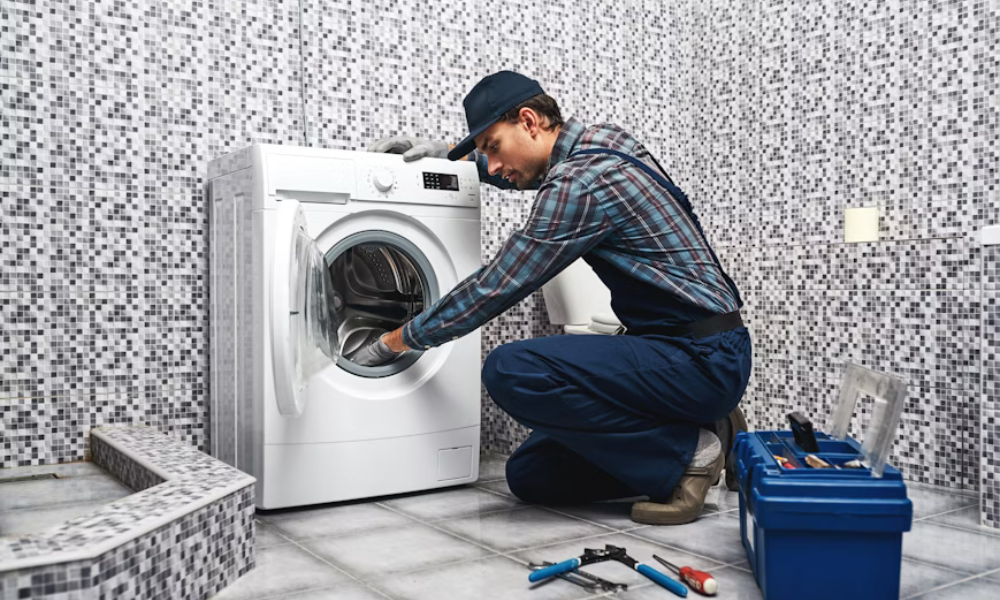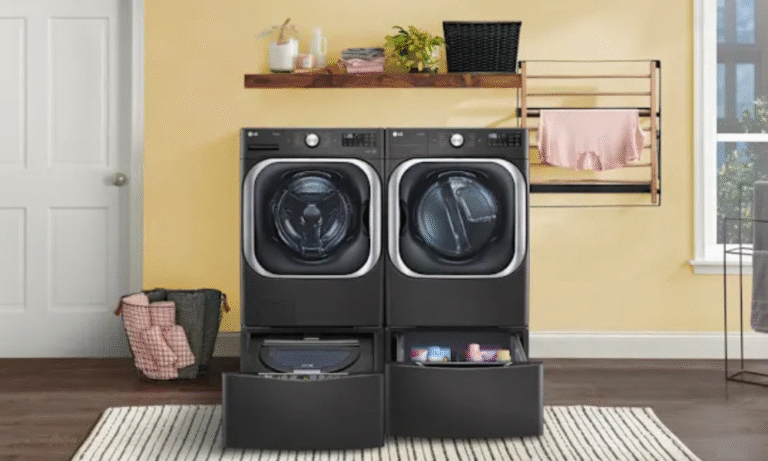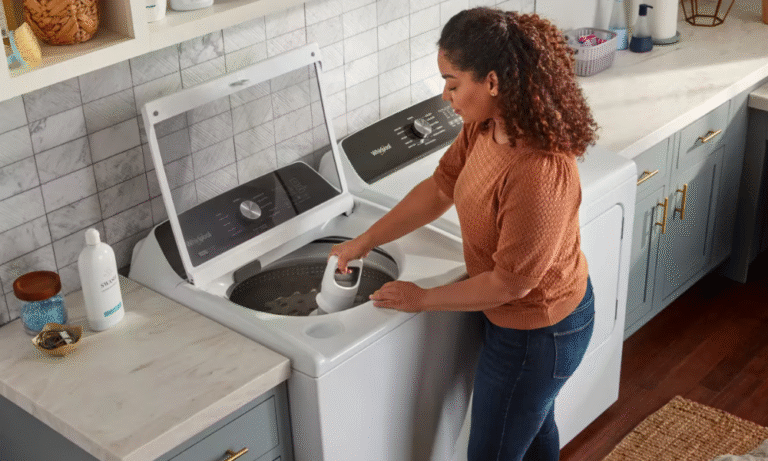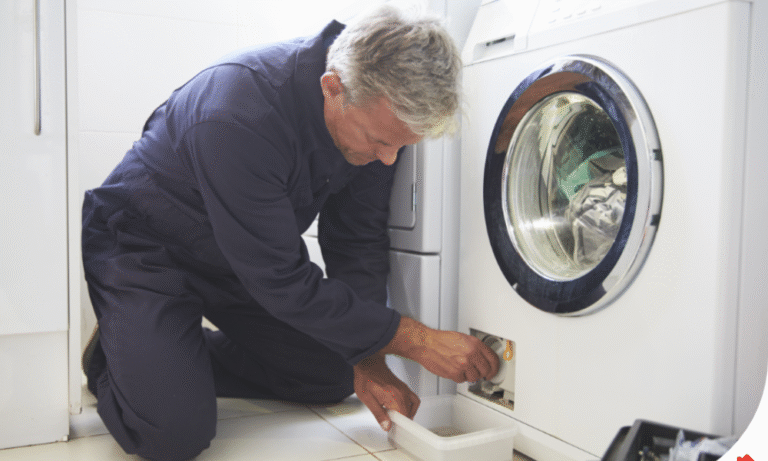Estimated reading time: 17 minutes
Last updated on August 23rd, 2025 at 02:22 am
In today’s modern houses, washing machines have become a vital device, altering the way we clean our clothes and making laundry activities more simple and effective. These wonderful technologies have saved us many hours and made it feasible to tackle enormous loads of laundry simply. However, like any complicated technology, washing machines are prone to malfunctions and faults that can impair their regular performance.
This article attempts to shed light on the numerous problems that may develop with washing machines and give a complete guide on how to troubleshoot and fix them. Whether it’s a leaky hose, a malfunctioning motor, or a perplexing error code, understanding the inner workings of these appliances and having the ability to fix them may save you time, money, and the bother of waiting for professional repair service.
What Is Washing Machine Basics
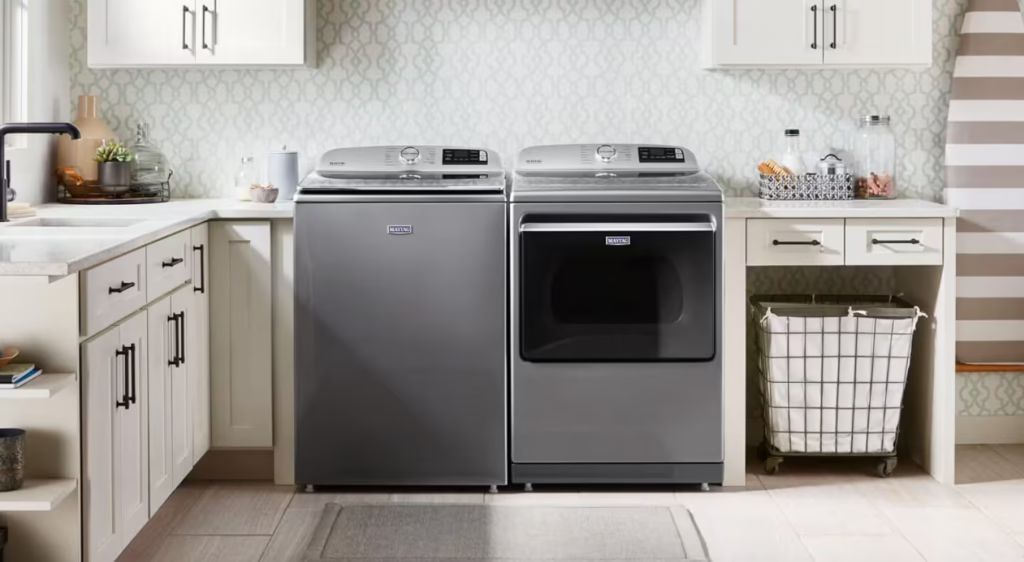
Photo Credit: maytag
How Does a Washing Machine Work?
Washing machines are complex appliances that rely on a combination of mechanical, electrical, and plumbing components to clean our clothes effectively. To analyze and fix any potential problems, you must have a thorough understanding of how they operate.
Washing machine components
A standard washing machine is made up of a number of essential parts that cooperate to offer a comprehensive cleaning procedure. These elements consist of:
Drum: The drum is the central part of the washing machine where clothes are loaded for cleaning. It agitates and spins the clothing, making it easier to get rid of stains and dirt.
Motor: The motor drives the rotation of the washing machine’s drum and regulates its numerous cycles and settings.
Pump: During the spin cycle, the pump is in charge of emptying the water from the machine.
Agitator or Impeller: These are found in top-load washing machines and help to create a swirling motion of water and detergent to clean the clothes.
Control panel: The control panel enables users to choose from a variety of cycles, modify settings, and keep track of the status of the washing cycle.
Washing Machine Cycle Explained
Understanding the different cycles of a washing machine is essential for optimal laundry results. Here are the main cycles often available in washing machines, however, the particular options may differ across models:
Fill: In this cycle, detergent is added after the machine has been filled with water to make a cleaning solution.
Agitate: During the agitate cycle, the agitator or impeller moves the clothing in the water in order to loosen stains and grime.
Fresh water is provided throughout this cycle to rinse any remaining detergent from the clothing.
Spin: Using centrifugal force, the spin cycle rapidly turns the drum to remove extra water from the clothing.
Drain: This cycle drains the water from the machine before moving to the next stage.
Dry (Optional): Some washers are equipped with a drying feature that can tumble dry clothes or offer a partial drying procedure.
Common Types of Washing Machines
There are many different types of washing machines, each with a unique set of features and advantages. The most typical varieties include:
Top-Load Washing Machines
Top-load washing machines feature a cover on top and a drum that is vertically oriented. They often require minimal maintenance and are renowned for being simple to load and unload. To move the clothing throughout the wash cycle, these machines frequently contain an agitator in the center.
Front-Load Washing Machines
The drum of front-load washing machines is horizontal, and the front entrance is located there. They are renowned for their water and energy savings as well as for their careful handling of clothing. Front-loaders often provide more advanced features and a bigger capacity.
High-Efficiency (HE) Washing Machines
Compared to conventional models, high-efficiency washing machines are made to consume less water and energy. They offer unique capabilities including the capacity to assess load size and change water levels accordingly, higher spin rates, longer wash cycles, and more. Both top-load and front-load versions of HE machines are common.
The basis for diagnosing and fixing common problems is laid by having a basic understanding of how washing machines operate and the many varieties that are available. We will examine particular issues that could develop and walk you through the repair procedure in the sections that follow.
Troubleshooting and Identifying Issues

Photo Credit: butterflygroupbd
Signs of Washing Machine Problems
When having issues, washing machines can display a variety of symptoms. Pay attention to the following warning signs that your washing machine may be having problems:
Unusual noises during operation, such as grinding, squeaking, or banging.
leaks of water around the hoses and connectors or from the machine itself.
excessive shaking or vibrations that make the machine move or walk.
the improper spinning of the laundry or laundry that is still wet after the cycle.
failure to turn on or start the washing machine.
persistently foul smells coming from the equipment.
Basic Troubleshooting Steps
Before diving into more particular difficulties while dealing with washing machine issues, it is important to follow these fundamental troubleshooting steps:
Power and Connections:
– Ensure the washing machine is properly plugged into a functioning power outlet.
– Check the circuit breaker or fuse box for any tripped breakers or blown fuses.
– Verify the water supply valves are fully open and the hoses are securely connected.
Balance and Load:
– Be careful not to overload the machine as this might wear out the motor and reduce efficiency.
– Arrange the clothing within the drum equally to keep it balanced throughout the spin cycle.
Maintain and Clean:
– Regularly clean the detergent dispenser drawer and remove any residue or buildup.
– Clean the lint filter or trap, if applicable, to prevent clogging and improve drainage.
– Carry out the manufacturer’s suggested preventive maintenance procedures.
Common Washing Machine Issues
Leaking Water
- Water leaks are a frequent problem that can occur for a number of reasons. The following procedures can help you find this issue and fix it:
- Look for leaks or damage in the water input hoses and connectors. If required, tighten connections or replace the hoses.
- Make that there are no rips or blockages in the door gasket or seal. Regular cleaning will provide a good seal.
- Examine the drain pump’s filter and the drain pump itself for obstructions. Make sure the drainage is good and remove any debris.
Excessive Noise or Vibrations
Excessive noise and vibration might be a sign of an internal component issue or an imbalance. Think about the following actions:
- Ensure the machine is level on the floor. If necessary, adjust the leveling feet.
- Check for foreign objects, like coins or buttons, trapped between the drum and tub. Eliminate any obstacles.
- Inspect the shock absorbers or suspension rods for wear or damage. Replace as required.
Not Spinning Properly
Follow these troubleshooting methods if the washing machine is not spinning correctly or is leaving clothing wet:
- Verify if the load is balanced. Adjust the clothing to equally distribute the weight.
- Make sure drainage is not impeded by cleaning the drain pump filter.
- Check for wear and tear on the motor coupling or drive belt. Replace as necessary.
Failure to Start or Power On
- Take the following actions if the washing machine won’t turn on or start:
- Verify that the power cord is firmly inserted into a functional outlet.
- Look for any blown fuses or tripped breakers in the circuit breaker or fuse box.
- As certain models feature safety systems that inhibit operation if the door or lid is not properly closed, make sure they are.
Foul Odors
- The following steps can be used to get rid of lingering bad smells in the washing machine:
- White vinegar should be added to a hot water cycle to get rid of smells and residue.
- Before using, make sure the detergent dispenser drawer has been well-cleaned and is dry.
- Leave the door or lid open after each cycle to allow the machine to air out and prevent moisture buildup.
By taking care of these typical problems and observing the
You can usually fix issues with your washing machine on your own by following troubleshooting procedures. However, it is advised to get assistance from a competent specialist if the problem persists or necessitates technical knowledge.
DIY Washing Machine Repair
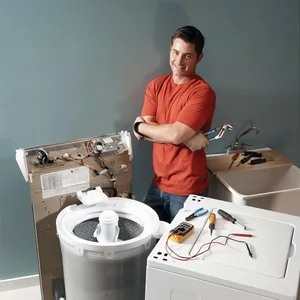
Photo Credit: familyhandyman
Safety Precautions Before Repairing
Prioritize your safety before performing any DIY repairs on your washing machine. Take these safety measures:
Cut the power: To prevent electric shock, unplug the washing machine from the outlet.
Turn off the water supply: Shut off the water supply valves to prevent leaks or water damage.
Wear safety equipment: To protect your hands and eyes from any potential threats, wear gloves and safety goggles.
Tools and Materials Needed to
assemble the equipment and supplies listed below in order to effectively repair your washing machine:
Screwdriver set: A collection of various shapes and sizes of screwdrivers.
Adjustable wrench: For loosening and tightening nuts and bolts.
Pliers: They are useful for grasping and adjusting various parts.
Replacement components: Depending on the exact repair, you could require things like a belt, filter, drain pump, or water intake valve. Make sure they work with the model of your washing machine.
Towels or containers: Use these to catch water or protect the floor during repairs.
Step-by-Step Repair Instructions
Replacing a Faulty Water Inlet Valve
- Turn off the water supply and unplug the washing machine.
- Locate the water inlet valve at the back of the machine, typically connected to the hoses.
- The inlet hose connections to the valve can be loosened and disconnected using pliers.
- Any screws or mounting brackets holding the valve in place should be removed.
- The valve’s electrical contacts should be disconnected.
- Connect the hoses, tighten the connections, and install the new water inlet valve.
- Reattach the electrical contacts, then screw or install mounting brackets to the valve to keep it in place.
- Check for leaks after turning on the water supply.
Cleaning or Replacing the Drain Pump
- Locate the drain pump, which is often at the front or bottom of the washer, and unplug it.
- To catch any water, place a towel or container underneath the pump.
- Follow the manufacturer’s directions while removing the pump cover or access panel.
- Clear the space surrounding the pump impeller and clean it to get rid of any dirt or impediments.
- Cut the hoses and electrical connections if the pump is broken or not working properly.
- Reconnect the hoses and electrical connections before installing the new pump.
- Reinstall the pump cover or access panel securely.
Fixing a Clogged or Faulty Filter
- Locate the filter, which is normally towards the front-bottom of the machine, then unplug the washing machine.
- To capture any water, place a towel or container underneath the filter.
- Open the filter cover and carefully remove the filter.
- Clean the filter by rinsing it under running water, removing any debris or blockages.
- Replace the filter with a new one that is compatible if it is severely damaged or blocked.
- Close the filter cover after reinstalling the filter and making sure it is firmly in place.
Addressing Belt or Motor Issues
- Access the belt or motor, which is normally found at the bottom or rear of the washer, by unplugging it.
- Check the belt for wear indicators like fractures or fraying. Replace it with a new, suitable belt if it is damaged.
- Refer to the manufacturer’s troubleshooting guidelines for motor problems or seek the advice of a qualified technician.
- To replace the belt or fix issues with the motor, according to the manufacturer’s detailed instructions.
- After the repair is finished, connect the device in and perform a test cycle to guarantee good operation.
Remember to consult the manufacturer’s instructions or online resources specific to
your washing machine model for accurate guidance. To prevent any more damage or safety hazards, it is preferable to call a professional technician if a repair looks complicated or calls for specialist equipment.
These do-it-yourself repair guidelines may help you fix typical washing machine problems and get your equipment back in working order.
When to Call a Professional

Photo Credit: home
Assessing the Complexity of the Issue
Even while DIY fixes might save money, there are times when it’s advisable to contact a reputable washing machine repair service. To determine the issue’s complexity, take into account the following elements:
Lack of technical knowledge: It is safest to seek expert assistance if you are unfamiliar with the inner workings of washing machines or if you have little to no experience repairing appliances.
Risks to safety: If repairs aren’t done properly, touching electrical parts or dealing with water connections might be dangerous. Call a professional if you’re doubtful about your capacity to complete the repair safely.
Warranty considerations: If your washing machine is still under warranty, attempting repairs on your own could void the warranty. It is advised to speak with the manufacturer or a licensed service provider in such circumstances.
Unusual or complex problems: If the issue is not covered in the manufacturer’s troubleshooting guide or requires specialized tools, it’s best to leave the repair to professionals who have the expertise to diagnose and fix uncommon or intricate problems.
Finding a Reliable Washing Machine Repair Service
It’s critical to locate a trustworthy washing machine repair business before opting to employ a professional. To make sure you pick the best service provider, follow these steps:
Research and ask for recommendations: Seek recommendations from friends, family, or online forums for trustworthy repair services with positive reviews.
Check credentials and experience: Look for licensed and certified technicians who have experience specifically in washing machine repairs. Make sure they are familiar with your specific brand and model.
Verify insurance and warranties: Confirm that the repair service has liability insurance to cover any damages that may occur during the repair. Also, find out whether there are any guarantees offered for their labor or replacement components.
Request estimates: Contact multiple repair services and request detailed estimates for the repair job. While comparing rates, keep in mind each provider’s standing and the level of service they give.
Ask about guarantees: Inquire about any guarantees or warranties offered on the repair work performed. A trustworthy service provider has to stand behind their job and guarantee client happiness.
Cost Considerations
Cost factors are important in determining whether to call a professional. Be mindful of the following:
Cost of components: Take into account how much the replacement parts needed for the repair will cost. When opposed to finding the components on your own, professional repair services may have access to lower wholesale costs, potentially saving you money.
Time and effort: Determine how much time and effort will be needed to identify and resolve the problem. DIY repairs can take a while, and making mistakes might make them take longer. You may reduce your irritation and save time by calling a professional.
Long-term savings: Professional repairs could be more expensive up front, but they can stop additional harm and potential failures. Long-term cost savings come from the tendency of properly serviced machinery to last longer.
Service charges: Find out what the service prices are for the expert repair services. Recognize whether they charge a fixed rate or an hourly rate for their services. When calculating the entire cost of the repair, take these costs into consideration.
You may decide whether to try a DIY repair or hire a professional by carefully evaluating the intricacy of the issue, choosing a reputable repair service, and assessing financial factors. Keep in mind that your washing machine’s safety and functionality should always come first.
Maintenance Tips for Longevity
Regular Cleaning and Maintenance Routine
Maintain a regular cleaning and maintenance schedule for your washing machine to maintain durability and peak performance. Think about the following actions:
Cleaning the detergent dispenser and the drum
- Wipe down the drum: After completing your laundry, wipe the inside of the drum with a clean, damp cloth to remove any residue or lint.
- Clean the detergent dispenser: Remove the detergent dispenser tray and rinse it thoroughly with warm water to remove any detergent buildup. Before re-inserting, let it totally dry.
- Prevent mold and mildew: Leave the washing machine door open after each use to allow air circulation and prevent the growth of mold and mildew.
Clearing Lint and Debris from Filters
- Check and clean the filter regularly: Consult your washing machine’s user manual to locate and access the filter. Depending on the model, it can be inside the drum or next to the front bottom panel. To ensure adequate drainage and avoid blockages, remove any lint or debris that has gathered in the filter.
- Clear the drain pump filter: If your washing machine has a drain pump filter, clean it periodically to ensure efficient water drainage. For details on how to reach and clean the drain pump filter, consult your user handbook.
Preventative Measures for Common Issues
In addition to routine cleaning, adopting precautions can help prevent typical washing machine problems. Think about the following:
Avoiding Overloading the Machine
- Observe the manufacturer’s recommendations: Comply with the manufacturer’s suggested load capacity. The machine’s motor, belts, and other components may get stressed by overloading, which will result in early wear and tear.
- Evenly distribute the load in the drum to keep it balanced during the washing cycle. Uneven loads might result in excessive vibrations and possible machine damage.
Using the Appropriate Detergents and Settings
Use the proper detergent: Make sure you are using the correct kind and quantity of detergent for your washing machine, as advised by the manufacturer. The operation of the machine might be affected by soap residue accumulation brought on by using too much detergent or the incorrect kind.
Choose the proper settings: For various types of washing, use the right wash cycles and settings. Use mild cycles for fragile materials, while more robust settings may be needed for highly dirty goods. Making the proper adjustments might spare the machine from needless strain.
You can increase the lifespan of your washing machine, keep it operating at its best, and avoid frequent problems by implementing these maintenance guidelines into your routine. To enjoy a dependable and effective washing machine for years to come, regular cleaning and suitable usage techniques are essential.
Conclusion
This post helped me understand, troubleshoot, and repair washing machines. Maintenance, typical difficulties, and DIY fixes are described. Regular cleaning, safety precautions, and understanding when to call an expert for difficult repairs are important. These tips can help your washer last longer and work better.
Always maintain and repair your washing machine. Maintain the drum and detergent dispenser, remove lint and debris from filters, and avoid overloading washing using improper detergents. Seek expert help for significant difficulties or safety concerns.
Use this article to fix your washing machine. Clean clothes and a long-lasting washing machine are possible with proper maintenance.
VII. Frequently Asked Questions (FAQs)
1. How often should I clean my washing machine?
Depending on usage, it is advised to clean your washing machine every one to three months. Regular cleaning assists in removing dirt and detergent scum and hinders the growth of mold and mildew.
2. Why is my washing machine leaking water?
Water leaks can occur for a number of causes, including a broken water intake valve, frayed hoses, or an old door seal. To stop more harm, it’s critical to locate the leak’s source and fix it quickly.
3. Can I repair a washing machine without professional help?
While some simple problems may be fixed by the homeowner, experts should be consulted for major concerns or those requiring electrical components. It is safer to seek expert advice to reduce dangers if you are unsure or lack experience.
4. How long do washing machines typically last?
Washing machines typically last between 10 and 15 years. However, the lifetime might differ based on the machine’s quality, how it is used, and how well it is maintained. Your washing machine can last longer with routine upkeep and prompt repairs.
5. What should I do if my washing machine won’t drain?
Check for obstructions in the drain hose or pump filter if your washing machine won’t drain. Make that the line is not kinked or broken, and remove any obstructions. If the problem continues, additional investigation or expert help may be needed to identify the root of the problem and offer a fix.
